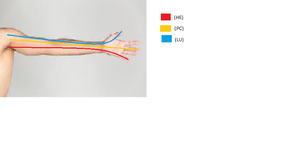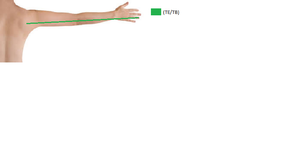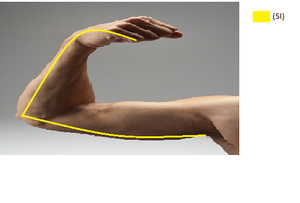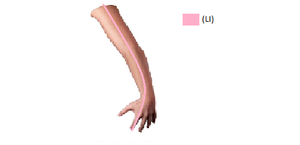Upper Limb Acupuncture Points: Difference between revisions
No edit summary |
No edit summary |
||
| Line 21: | Line 21: | ||
|[[File:Lateral arm1.png|center|frameless]]-Large Intestine (LI) | |[[File:Lateral arm1.png|center|frameless]]-Large Intestine (LI) | ||
|} | |} | ||
Table 1. Meridian channels of the upper extremity <ref name=":0">Macdonald A. Acupuncture Main Channels or Meridians: Visible Surfaces. Int J Complement Alt Med 2017;7:00233.</ref> | Table 1. Meridian channels of the upper extremity <ref name=":0">Macdonald A. Acupuncture Main Channels or Meridians: Visible Surfaces. Int J Complement Alt Med 2017;7:00233.</ref> | ||
== Location & Usage: == | |||
=== Pericardium Meridian: === | |||
The pericardium channel consists of nine [[acupuncture]] points. The channel originates from the chest lateral to the nipple and travels upwards to the axillary fossa. It then descends down the anterio-medial aspect of the arm to the cubital fossa and continues between [[Palmaris Longus]] and [[Flexor Carpi Radialis]]. The channel terminates at the tip of the third digit. | |||
Key Point: | |||
Pericardium 6 (PC6)- 2 Cun above the wrist crease, located between Palmaris Longus and Flexor Carpi Radialis. Used as an antiemetic point especially during pregnancy and post-operative pain. | |||
=== Heart Meridian: === | |||
The Heart Meridian consists of nine acupuncture points. The channel originates from the centre of the axilla and descends through the anterio-medial aspect of the arm to the pisaform region, terminating at the tip of the little finger. | |||
Key points: | |||
HT3- Medial end of the transverse cubital crease. Used for forearm/hand numbness and pain, tremors, elbow injuries and neck stiffness | |||
HT7- On the transverse wrist crease, between the pisiform and ulna bones. Used for wrist pain. | |||
=== Lung Meridian: === | |||
The Lung Meridian consists of eleven acupuncture points. The channel originates on the lateral chest and descends through the anterio-medial region of the upper arm. It crosses over to the lateral aspect of the arm at the cubital fossa and continues to the radial side of the wrist, terminating at the tip of the thumb. | |||
Key points: | |||
LU5- At the cubital crease, lateral to the [[biceps brachii]] tendon. Used for pain caused by elbow, shoulder and thoracic injuries. | |||
LU7- Radial region of the forearm, superior to the tip of the radial styloid process. Used for paralysis of the fascial muscles, jaw pain and soft tissue injuries of the wrist. | |||
LU9- Anterio-lateral aspect of the wrist crease, radial side of the radial artery. Used for forearm and wrist pain and associated local soft tissue injuries. | |||
=== Triple Energiser/Burner: === | |||
The triple energiser/triple burner consists of 23 acupuncture points. The channel originates from tip of the ring finger and ascends through the posterior aspect of the arm until it reaches the shoulder. It terminates at the outer end of the eyebrow. | |||
Key points: | |||
TE5- On the dorsal surface of the forearm, between the radius and ulna, 2 cun superior to the dorsal transverse wrist crease. Used for facial pain, stiffness of the neck, shoulder arthritis and arm/elbow pain. | |||
TE14- On the posterior deltoid region, in the depression of the lateral border of the acromion. Used for shoulder/arm pain, restricted range of motion and soft tissue injuries. | |||
=== Small Intestine: === | |||
This channel consists of 19 acupuncture points. It originates at the tip of the 5th digit and ascends along the ulnar border to the [[scapula]]. Here it zig zags across the [[scapula]] and terminates at the anterior aspect of the ear. | |||
Key points: | |||
SI3- Proximal to the base of the 5th metacarpal bone, at the junction of the red and white skin. Used for lumbar, neck, shoulder and arm pain, headaches. | |||
SI8- In the depression between the medial epicondyle of the humerus and olecranon, when the elbow is flexed. Used for pain in the arm, elbow, shoulder and scapular region and cervical spine pain or restricted range of motion. | |||
SI9- 1 cun superior to the posterior end of the axillary fold with the arm in abduction. Used for motor function impairment of the arm, pain/injuries along the arm/shoulder or scapular region. | |||
SI10- With the arm still abducted, 1 cun superior to SI 9 in the depression inferior and lateral to the scapular spine, Used for motor function impairment of the arm. Pain and/or weakness of the arm. Shoulder/scapular injuries. | |||
SI11- one-third the distance between the inferior angle of the scapula and the lower border of the scapular spine, in the depression of the infrascapular fossa, Used for pain in the elbow, shoulder and/or scapular region. | |||
=== Large Intestine: === | |||
This Meridian consists of 20 acupuncture points. It originates at the tip of the 2nd digit and ascends along the lateral aspect of the arm to the tip of the shoulder. It continues travelling upwards to terminate at the opposite side of the face. | |||
Key points: | |||
LI4- On the dorsum aspect of the hand, in the belly of the first interosseus dorsalis muscle, at the midpoint of the second metacarpal bone. Used during difficult labour, arm pain, headaches and facial paralysis. | |||
LI11- On the lateral aspect of the cubital crease at near end range elbow flexion. Used for pain or paralysis of the arm, pain or shoulder arthritis and following elbow injuries. | |||
LI14- On the inferior border of the deltoid, on the line connecting LI11 and LI15. Used for shoulder/arm pain | |||
LI15- Anterior and inferior to the acromion when the arm is abducted. Used for motor function impairment of the upper limb, shoulder pain and soft tissue injuries. | |||
== Evidence-based practice == | |||
== References == | == References == | ||
[[Category:Acupuncture]] | [[Category:Acupuncture]] | ||
<references /> | <references /> | ||
Revision as of 02:48, 19 September 2020
Meridians of the Upper Extremity[edit | edit source]
| Anterior: | Posterior: |
|---|---|
| - Pericardium Channel (PC)
- Heart (HE) - Lung (Lu) |
- Triple Energizer/Burner (TE/TB) |
| Medial: | Lateral: |
| -Small Intestine (SI) | -Large Intestine (LI) |
Table 1. Meridian channels of the upper extremity [1]
Location & Usage:[edit | edit source]
Pericardium Meridian:[edit | edit source]
The pericardium channel consists of nine acupuncture points. The channel originates from the chest lateral to the nipple and travels upwards to the axillary fossa. It then descends down the anterio-medial aspect of the arm to the cubital fossa and continues between Palmaris Longus and Flexor Carpi Radialis. The channel terminates at the tip of the third digit.
Key Point:
Pericardium 6 (PC6)- 2 Cun above the wrist crease, located between Palmaris Longus and Flexor Carpi Radialis. Used as an antiemetic point especially during pregnancy and post-operative pain.
Heart Meridian:[edit | edit source]
The Heart Meridian consists of nine acupuncture points. The channel originates from the centre of the axilla and descends through the anterio-medial aspect of the arm to the pisaform region, terminating at the tip of the little finger.
Key points:
HT3- Medial end of the transverse cubital crease. Used for forearm/hand numbness and pain, tremors, elbow injuries and neck stiffness
HT7- On the transverse wrist crease, between the pisiform and ulna bones. Used for wrist pain.
Lung Meridian:[edit | edit source]
The Lung Meridian consists of eleven acupuncture points. The channel originates on the lateral chest and descends through the anterio-medial region of the upper arm. It crosses over to the lateral aspect of the arm at the cubital fossa and continues to the radial side of the wrist, terminating at the tip of the thumb.
Key points:
LU5- At the cubital crease, lateral to the biceps brachii tendon. Used for pain caused by elbow, shoulder and thoracic injuries.
LU7- Radial region of the forearm, superior to the tip of the radial styloid process. Used for paralysis of the fascial muscles, jaw pain and soft tissue injuries of the wrist.
LU9- Anterio-lateral aspect of the wrist crease, radial side of the radial artery. Used for forearm and wrist pain and associated local soft tissue injuries.
Triple Energiser/Burner:[edit | edit source]
The triple energiser/triple burner consists of 23 acupuncture points. The channel originates from tip of the ring finger and ascends through the posterior aspect of the arm until it reaches the shoulder. It terminates at the outer end of the eyebrow.
Key points:
TE5- On the dorsal surface of the forearm, between the radius and ulna, 2 cun superior to the dorsal transverse wrist crease. Used for facial pain, stiffness of the neck, shoulder arthritis and arm/elbow pain.
TE14- On the posterior deltoid region, in the depression of the lateral border of the acromion. Used for shoulder/arm pain, restricted range of motion and soft tissue injuries.
Small Intestine:[edit | edit source]
This channel consists of 19 acupuncture points. It originates at the tip of the 5th digit and ascends along the ulnar border to the scapula. Here it zig zags across the scapula and terminates at the anterior aspect of the ear.
Key points:
SI3- Proximal to the base of the 5th metacarpal bone, at the junction of the red and white skin. Used for lumbar, neck, shoulder and arm pain, headaches.
SI8- In the depression between the medial epicondyle of the humerus and olecranon, when the elbow is flexed. Used for pain in the arm, elbow, shoulder and scapular region and cervical spine pain or restricted range of motion.
SI9- 1 cun superior to the posterior end of the axillary fold with the arm in abduction. Used for motor function impairment of the arm, pain/injuries along the arm/shoulder or scapular region.
SI10- With the arm still abducted, 1 cun superior to SI 9 in the depression inferior and lateral to the scapular spine, Used for motor function impairment of the arm. Pain and/or weakness of the arm. Shoulder/scapular injuries.
SI11- one-third the distance between the inferior angle of the scapula and the lower border of the scapular spine, in the depression of the infrascapular fossa, Used for pain in the elbow, shoulder and/or scapular region.
Large Intestine:[edit | edit source]
This Meridian consists of 20 acupuncture points. It originates at the tip of the 2nd digit and ascends along the lateral aspect of the arm to the tip of the shoulder. It continues travelling upwards to terminate at the opposite side of the face.
Key points:
LI4- On the dorsum aspect of the hand, in the belly of the first interosseus dorsalis muscle, at the midpoint of the second metacarpal bone. Used during difficult labour, arm pain, headaches and facial paralysis.
LI11- On the lateral aspect of the cubital crease at near end range elbow flexion. Used for pain or paralysis of the arm, pain or shoulder arthritis and following elbow injuries.
LI14- On the inferior border of the deltoid, on the line connecting LI11 and LI15. Used for shoulder/arm pain
LI15- Anterior and inferior to the acromion when the arm is abducted. Used for motor function impairment of the upper limb, shoulder pain and soft tissue injuries.
Evidence-based practice[edit | edit source]
References[edit | edit source]
- ↑ Macdonald A. Acupuncture Main Channels or Meridians: Visible Surfaces. Int J Complement Alt Med 2017;7:00233.










